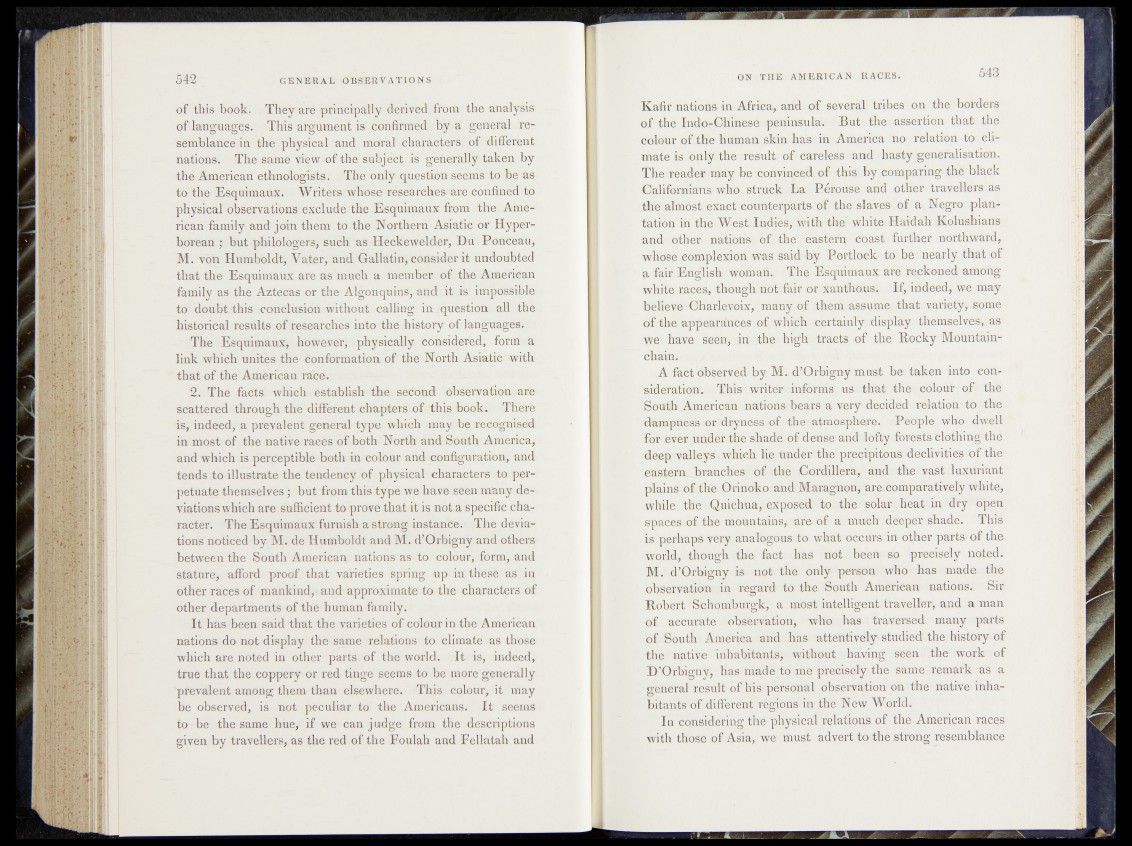
of this book. They are-prinCipally derived from the analysis
of languages. This argument isst confirmed, by. a «general resemblance
in the "physical and moral characters' of different
natio|fe- The same view of teq subject is generally taken by
the American ethnologists. The only question seems' to be as
to the Esquimaux. Writers whose researches-are confihedvto
physical observations exclude the Esquimaux from the-American
family and join them to the Northern Asiatic or Hyperborean
; but philologers^sueh as Heckewelder, Du Ponceau,
M. vôïi Humboldt, Yater, and Gallatin, consider it undoubted
that the Esquimaux are as much a member of the American
family as the Aztecas or the Algonquins, and it is impossible
to doubt this conclusion without calling in .question all the
historical results of researches into the history of langhêgifty ?
The Esquimaux, however, physically considered, form a
link which unites the conformation of the North Asiatic with
that of the American race.
2. The facts which establish the second observation are
scattered through the different chapters of this book. There
is, indeed, a prevalent general type which may be recogniseff
in most of the native races of both North and South America,
and which is perceptible both in colour and configuration, and
tends to illustrate the tendency of physical characters to perpetuate
themselves ; but from this type we have seen many deviations
which are sufficient to prove that it is not a specific character.
Thë Esquimaux furnish a strong instance. The deviations
noticed by M. de Humboldt and M. d’Orbigny and others
between the South American nations as to colour, form, and
stature, afford proof that varieties spring up in' these as in
other races of mankind, and approximate to the characters of
other departments of the human family.
It has been said that the varieties of colour in the American
nations do not display the same relations to climate as those
which are noted in other parts of the world.. It is, indeed,
true that the coppery or red tinge seems to be more generally
^prevalent among them than elsewhere. This colour, it may
be observed, is not peculiar to the Americans. It seems
to be the same hue, if we can judge from the descriptions
given by travellers, as tee red of the Eoulah and Fellatah and
Kafir nations in Africa, arid' of several tribes on the borders
of the IndOTiGhinese peninsula.'. But the ( assertion that the
colour of the human, skin has in America no relation to climate
is 'only the*|iBsult^ of; carelsd^ and hasty ^generalisation.
The reader may be convinced of this; by comparing the black
Californians who struck La Perouserand other travellers as
the almost exact counterparts of the. slaves of a Negro plantation
in the West Indirisy&with the white Haidah Kelushiaos
and other nations of the eastern -coast -further northward,
whose .complexion was said by Portlock to be nearly that of
a fair English woman. The Esquimaux are reckoned; among
white Mces, though not fair or xanthous. If, indeed, we may
believe Charlevoix, many of them assume, .that variety^ some
of the appearances of which certainly display themselves, as
we have seen, in '.the high tracts of the Pocky Mountain-
chain.
A fact'observed by M. d?Orbigny must; he taken into consideration.
This writer informs us. that- ;the- colour of the
South American nations bears a very decided relation to the
dampness or: dryness of the atmosphere^ People who dwell
for ever under the shade of dense and lofty forests clothing the
deep valleys which lie under the precipitous declivities of the
eastemjbranchas of the Cordillera, and the vast luxuriant
plains of the Orinoko and Maragnon, are comparatively white,
while the Quichua, exposed to the solar heat in dry open
spaces of, the mountains, are of a much deeper shade. This
is perhaps very analogous to what occurs in other parts of the
world, though the fact has not been so precisely noted.
M. d?Orbigny is not the only person who has made the
observation in regard to the South American nations. Sir
Robert >§ehomburgk, a most intelligent traveller, and a man
of accurate observation, who has traversed many parts
of South America and has attentively studied th# history of
the native inhabitants, without having seen the work of
D’Orbigny, has made to me precisely the same remark as a
general result of his personal observation on the native inhabitants
of different regions in the New Worldv
In considering the physical relations of the American races
with those of Asia, we must advert to the strong resemblance